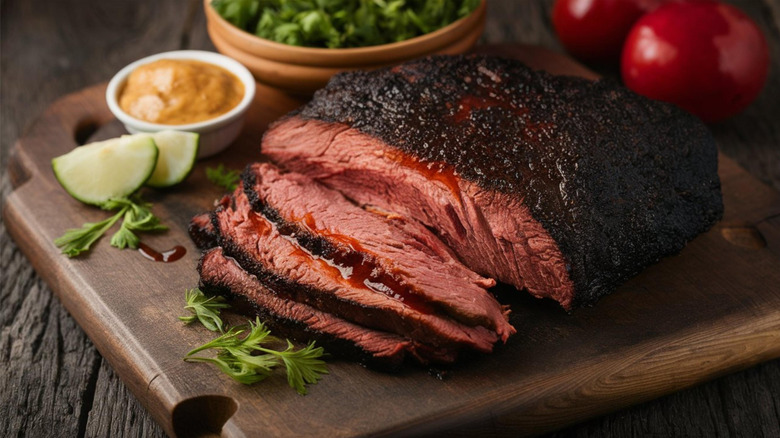How To Reheat Brisket So It's Just As Juicy As The First Time
We may receive a commission on purchases made from links.
Three words hold the key to a good smoked brisket: Low and slow. Arriving at that perfect, melt-in-your-mouth hunk of meat takes patience, timing, and a good cut of brisket to begin with. A properly stored brisket can reheat beautifully, but you need to know how to do it otherwise you risk drying it out and ruining the whole dish. With a little additional patience and a touch of effort, you can reheat and revive leftover brisket to deliver more of that meal-making tenderness.
We connected with Christie Vanover, owner, and pitmaster of Girls Can Grill, who had an ingenious way to reheat brisket so that it's just as juicy as the first time. "One of the best ways to reheat brisket to keep it juicy with a sous vide," she says. "Place the slices in a vacuum seal bag. If you shingle them in the bag like sliced bacon, they'll reheat more quickly. When it's time to reheat them, place the vacuum-sealed bag in a water bath with a sous vide circulator set to 140 degrees Fahrenheit. It will take one to two hours, depending on the thickness of the brisket."
Cooking with a sous vide may be intimidating at first, but it's an incredibly useful tool that helps you crank out restaurant-quality meat with minimal effort. If you're in the market for a sous vide, we recommend the Anova sous vide precision cooker — I've had one in my kitchen for five-plus years and couldn't be happier with it.
How to wrap you brisket for maximum moisture
Any brisket fan will tell you that moisture is tantamount to a flavorful and tender brisket. That's why you reach for a cut that has high marbling, i.e. lots of fat, to help deliver on the juiciness. Once you get past the first step — cooking a mouthwatering brisket — there are additional things you can do to keep the flavor flowing. For one, proper storage is crucial to getting a good piece of meat after the reheat. Cooked brisket can last in your freezer for up to two months and in the fridge for four days. All you need to do is tightly wrap your leftover brisket, ideally intact in as big a piece as possible, and place it in an airtight container.
When it comes to reheating, Christie Vanover has another method for those who don't have a sous vide: "As an alternative, you can place the sliced brisket in a pan with some beef broth. Cover the pan with foil and warm the slices in a 250-degree oven." This is another great way to re-infuse your meat with any moisture it might've lost during storage. And if you ever accidentally overcook your brisket, don't sweat it, it happens to the best of us. We recommend leaning into your mistake and deep frying your overcooked brisket for a crispy, beef-jerky version of the brisket you were originally cooking.

